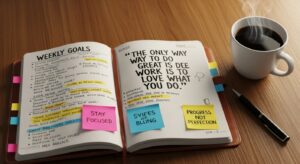When it comes to reaching your goals, hard work and strategy are essential—but so is your mindset. One of the most powerful mental tools you can use is visualization. This practice involves creating a clear and vivid mental picture of the outcome you want, engaging all your senses to make it feel real. Athletes, entrepreneurs, and high achievers across industries use visualization to stay motivated, sharpen their focus, and boost their performance.
Why Visualization Works
Visualization isn’t magic—it’s science. Studies show that when you imagine performing an action, your brain activates many of the same neural pathways as when you actually perform it. In other words, your brain practices success before it happens.
This has several benefits:
- Boosts motivation by making the goal feel tangible and achievable.
- Reduces anxiety by familiarizing you with situations before they happen.
- Improves performance by strengthening the mental “blueprint” for success.
The Mind-Body Connection
The brain doesn’t fully distinguish between imagined and real experiences. This means that consistent visualization can:
- Prime your muscles for physical performance (used widely in sports).
- Increase confidence by rehearsing success scenarios.
- Create a sense of inevitability about your goals, making you more likely to act in alignment with them.
How to Visualize Effectively
1. Get Specific
General visions like “I want to be successful” aren’t powerful enough. Instead, define what success looks like for you in detail. Where are you? Who is with you? What does your environment look like?
2. Engage All Your Senses
Don’t just see the outcome—feel it, hear it, even smell and taste it if possible. The more vivid the image, the stronger the neural connections.
3. Include the Process, Not Just the Result
It’s tempting to only picture the end goal, but visualizing the steps you’ll take builds confidence and prepares you for challenges.
4. Make It a Daily Habit
Spend at least 5–10 minutes each day visualizing your goals. The best times are first thing in the morning or before bed, when your mind is more receptive.
5. Pair Visualization with Action
Visualization is most effective when combined with concrete steps toward your goals. It’s a mental tool, not a substitute for effort.
Overcoming Common Visualization Mistakes
- Being inconsistent: Sporadic practice won’t create lasting change.
- Focusing only on perfection: Include potential challenges in your visualization so you’re prepared for them.
- Treating it as daydreaming: Visualization is intentional and structured, not passive wishful thinking.
Visualization in Real Life
- Athletes: Olympians often visualize their entire performance before stepping onto the field.
- Public speakers: Professionals rehearse speeches in their minds to boost confidence.
- Business leaders: Entrepreneurs visualize negotiations, launches, or presentations to prepare mentally.
The Emotional Fuel
Visualization works because it taps into emotion—the driving force behind motivation. When you connect emotionally to your vision, you create a powerful inner drive that pushes you forward even when things get tough.
Final Thoughts: See It, Then Be It
Visualization turns your goals from abstract ideas into concrete, emotionally charged images. It bridges the gap between where you are and where you want to be, helping you take more confident, purposeful action. When you consistently see yourself succeeding, you make it far more likely to become your reality.












